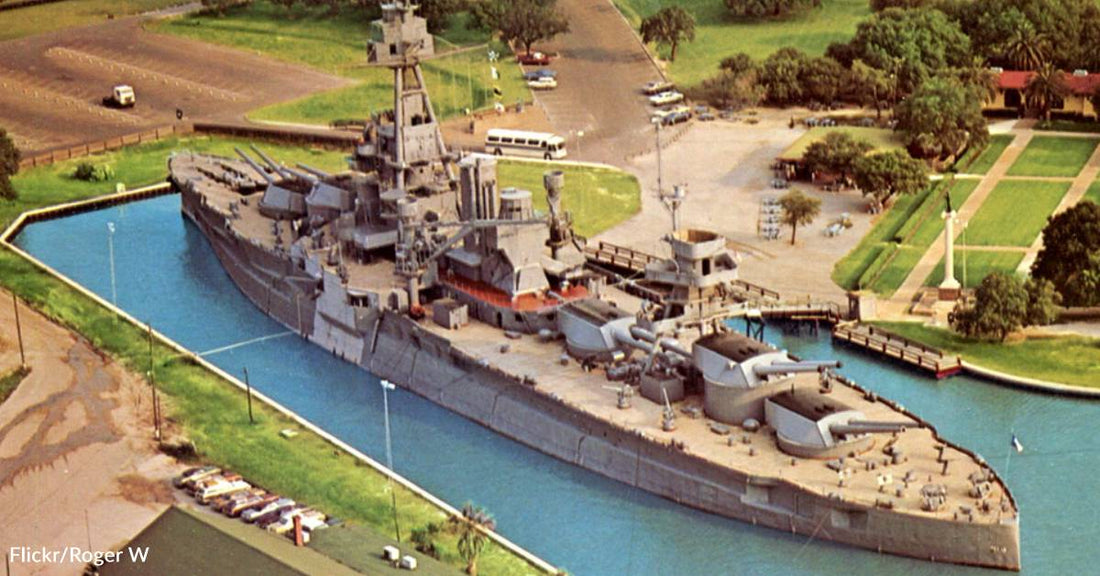The USS Texas (BB-35) at Normandy on D-Day - A Day of Ingenuity
Dan Doyle
There are times when ingenuity is required to get a job done, and in times of war, that seems to be true more often than not. This story is an example of the extreme and out-of-character ingenuity that is common when nothing else works. Sometimes in war, extreme situations require actions that are outside of all of the preparatory planning or the designs of the weapons brought to bear. Such situations force the use of ingenuity and, somehow, things are made to happen that are a matter of simple insight or pure genius. This is one of those stories. It involves the battleship USS Texas (BB-35), a New York-class battleship.
The USS Texas was commissioned on the 12th of March 1914. By 1938, she was scheduled for the scrapyards, but WWII gave her more life. She saw action in the Mediterranean early on, helping to defeat the Nazis in North Africa, and would end the war supporting our troops at Okinawa and Iwo Jima in the Pacific. But before that, she would be part of the D-Day operations at Normandy.
On June 3, 1944, three days before the landings on the Normandy beaches, the USS Texas sailed with the Western Taskforce to take part in the landings. The USS Texas, with her huge guns, was there to provide artillery and to soften the German defenses at the area called Pointe du Hoc in support of the American and allied troops tasked with taking that part of the beach and others.
The USS Texas was stationed about 12,000 yards offshore. When the orders were given, she poured 255 of her 14” shells into the German defensive positions at Pointe du Hoc in a matter of 34 minutes. She continued to provide support until the Allied troops were able to take Pointe du Hoc from the German defenders. When the invasion forces began to push inland off of the beaches, she went closer to shore, moving to within 3,000 yards. On June 7 and 8, she was still able to provide artillery support as the Allies pushed steadily inland until she was forced to leave the station and return to England to rearm. By the 11th of June, she was back off of the coast of France providing artillery support.
Soon, though, by the 15th of June, the allied forces had moved far enough inland that they were coming close to being out of range of her guns. She was still receiving requests for fire support though. And here is where one of those cases of extreme ingenuity came to play. Her guns did not have the necessary elevation that was needed to send their shells further. What to do?
Someone came up with an idea that most sailors would reject instinctively, but it was one of those necessities of war that had to be met with the available tools. The plan that they came up with proved to be ingenious and effective. You see, if the guns could not be elevated beyond their normal design limits, then the entire ship would have to be shifted to allow the guns to be elevated beyond those limits, in order to increase their range. In order to raise her port side guns to the required elevation, the order was given to cause the massive battleship to list to starboard. It was decided to flood the starboard torpedo blister, a sponson on the hull below the waterline. It was done quickly, and the ship was brought to a list of two degrees to starboard, which gave her main port side batteries just enough elevation to complete the fire mission that had been requested. And it worked! She continued to support the Allied troops as they continually moved eastward for one more day.
At the end of WWII, the USS Texas was 34 years old. She had been battle-hardened in two wars, WWI and WWII, but was no longer needed at the end of WWII. She was decommissioned in 1948 and became the nation’s first battleship museum on the 12th of April 1948. She is located at the San Jacinto Battleground State Historic Site in La Porte, Texas. She is open daily to the public 7 days a week from 10:00 a.m. to 5:30 p.m.

Dan Doyle is a husband, father, grandfather, Vietnam veteran, and retired professor of Humanities at Seattle University. He taught 13 years at the high school level and 22 years at the university level. He spends his time now babysitting his granddaughter. He is a poet and a blogger as well. Dan holds an AA degree in English Literature, a BA in Comparative Literature, and an MA in Theology, and writes regularly for The Veterans Site Blog.






















